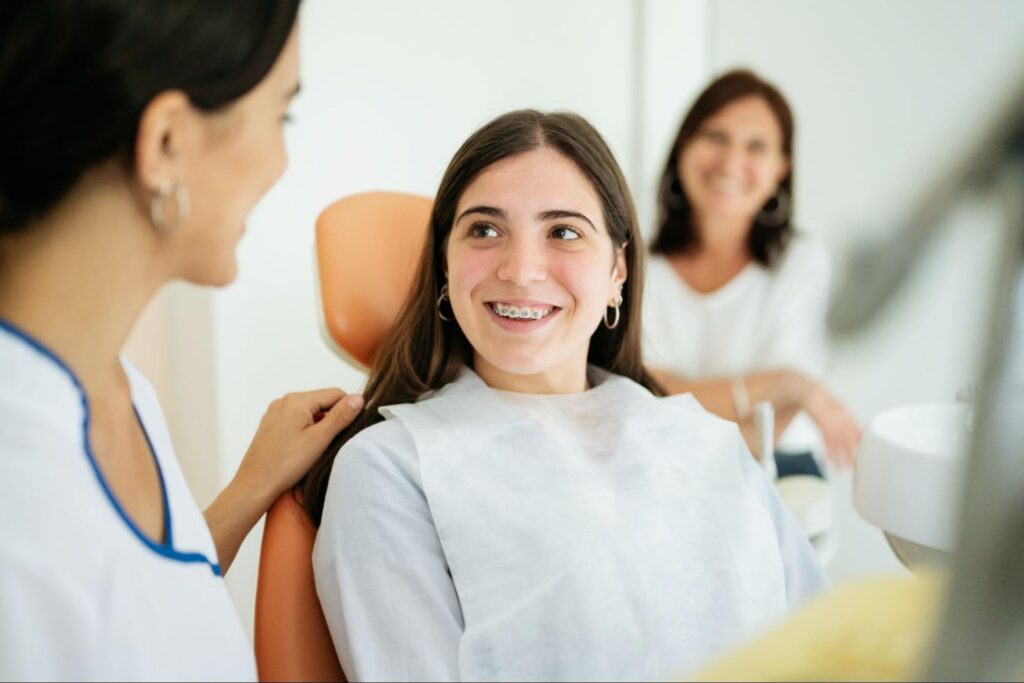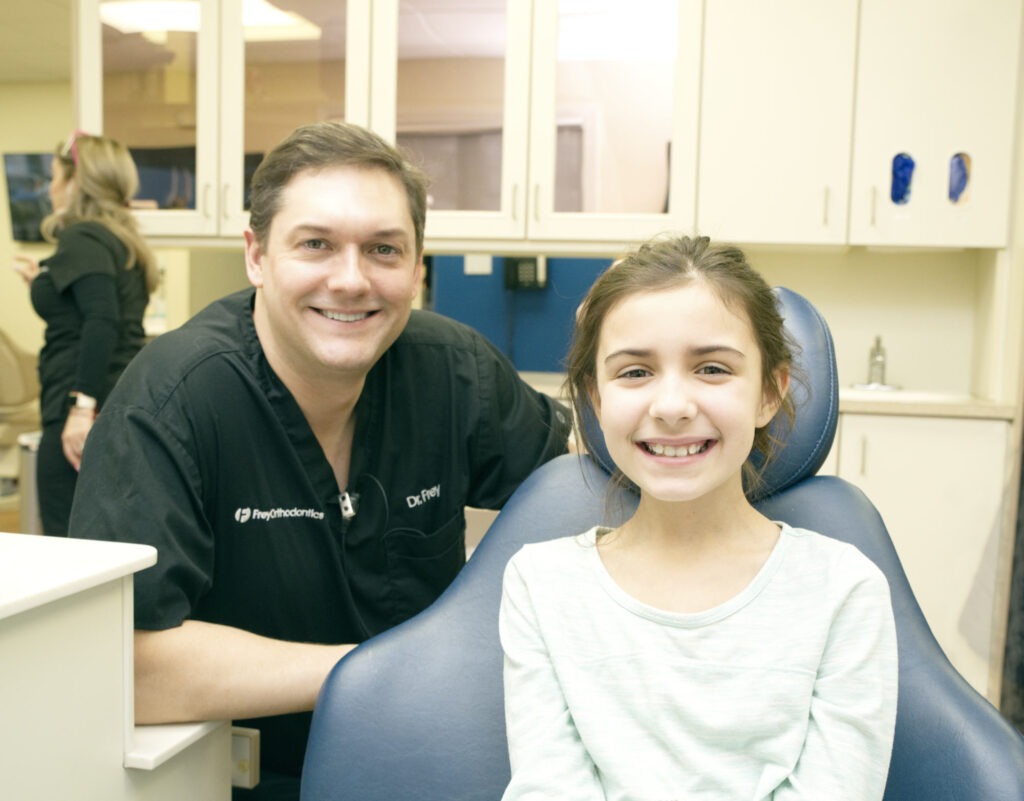When people think about orthodontics, they picture straight teeth. That’s a great start, but it isn’t the whole story. Teeth live inside a larger system: lips, cheeks, tongue, and the way the upper and lower jaws meet. When that system is out of balance, it can change how your smile looks, how your bite feels, and even how your face appears at rest. Aligning the bite helps the soft tissues “drape” more naturally, revealing a smile that fits your features rather than fighting them.
Dr. Frey and the team plan treatment around both tooth alignment and facial harmony. That means looking at the smile arc, incisor display, and how your bite supports the lower third of the face. The goal is a smile that looks great when you grin for a photo and still looks natural when you’re not thinking about it.
Function Feeds Style
Healthy function and a great style go hand in hand. A “good bite” distributes chewing forces evenly, reduces abnormal wear on enamel, and makes everyday hygiene simpler. When teeth and jaws line up, it’s easier to bite, chew, and speak clearly, and it’s easier to keep plaque at bay, which supports healthier gums. The American Association of Orthodontists highlights all of these benefits as life-enhancing outcomes of orthodontic care, not just cosmetic perks.
Bite, Muscles, and Everyday Comfort
Your jaw muscles work hard to compensate for misalignment. If teeth don’t meet properly, muscles and joints may overwork, which can contribute to soreness or uneven tooth wear. Aligning the bite reduces those compensations, supports more efficient chewing, and can make day-to-day function feel more natural. Academic centers echo the idea that creating a healthy bite helps distribute forces and support clearer speech and efficient chewing; these are all benefits you notice long after treatment ends.
Confidence You Can Feel (and Measure)
A straighter smile often brings a confidence boost. That’s not just anecdotal. Research links orthodontic treatment to improvements in self-esteem and oral-health-related quality of life for adults. In a frequently cited review, patients reported meaningful gains after treatment, reflecting changes they could feel in social interactions and daily life. Additional studies echo those findings across different age groups and settings.
Teens vs. Adults: What the Evidence Suggests
Teens may notice social and school-related benefits as teeth align and hygiene improves. Adults commonly report professional and personal confidence gains once alignment is complete. While everyone’s experience is personal, the trend in the literature is consistent: when you improve the foundation, meaning how teeth fit and function, then confidence tends to follow.
Can Orthodontics Change Your Profile?
Sometimes yes, sometimes not as much; it depends on the underlying structure. Tooth movement can influence lip support, smile arc, and how the lower third of the face looks at rest. For skeletal issues (e.g., significant jaw discrepancies), orthodontics may be paired with jaw surgery to change the facial profile in a predictable way. Combined orthodontic-orthognathic treatment can significantly enhance facial appearance in patients with certain profile types, whereas orthodontics alone has more limited profile-level effects in those same adult cases. That’s why diagnosis matters, and expectations should match anatomy.
During growth years, orthodontists can use timing to guide jaw relationships more effectively. In adults, we still achieve excellent bite and smile changes with braces or clear aligners; when larger skeletal corrections are desired, we discuss whether a combined approach makes sense. Either way, the plan starts with your goals and a clear picture of your facial balance today.
Everyday Benefits You’ll Notice
You’ll likely spot changes that go beyond your reflection. Properly aligned teeth are easier to brush and floss. That alone can lower the risk of cavities and gum inflammation. A better bite also reduces the chance of chipping or uneven wear and helps protect protruding front teeth from injury. These are practical gains you feel every time you clean your teeth or enjoy a meal, not just when you smile for a photo.
You can expect several benefits, including improved function, simpler hygiene, fewer dental emergencies, and a lower long-term risk, when alignment is corrected.
A balanced bite can even make day-to-day speaking feel easier for some patients. If certain sounds were tricky because of tooth position or an open bite, correcting the relationship between the arches can provide a clearer path for the tongue and lips. Your results will be individual, but the principle is the same: better alignment supports better function.

What This Looks Like
Modern orthodontics is flexible. Braces and clear aligners both move teeth with high precision; the best choice depends on your lifestyle, anatomy, and goals. Some patients prefer the structure and “always on” momentum of braces; others choose the removability and simplicity of aligners. At Frey Orthodontics, Dr. Dwight Frey evaluates how each option will influence your smile and the surrounding soft tissues, how much incisor display fits your face, how your smile arc complements your features, and how to achieve a healthy, stable bite that looks natural in real life.
Because we serve Naperville and Algonquin, you can expect a consistent, patient-first experience in either location. The process starts with records and a conversation about what you want to change. From there, we design a sequence that aims for facial harmony and long-term stability, and not just a quick change in the mirror.
FAQs: Beyond the Mirror
Will treatment make my lips look fuller?
Alignment can subtly change lip posture by improving tooth position and support. Dramatic “lip changes” are unlikely without skeletal changes; we’ll preview what’s realistic based on your anatomy.
Can orthodontics help my jawline?
By establishing a stable bite, orthodontics can reduce some muscular compensations that make the lower face look tense. True jawline changes require a careful diagnosis; in certain skeletal cases, a combined orthodontic-surgical plan may be discussed.
Is it worth it if my teeth are only a little crowded?
Often yes. Even small alignment changes can make hygiene easier, reduce plaque traps, and improve the way your smile sits in your face. AAO resources emphasize function as a core outcome, since straighter teeth are simpler to care for.

Ready for a Smile That Fits Your Face?
Orthodontics is about harmony, and that means teeth that fit together, muscles that work efficiently, and a smile that complements your features. Straight teeth are a milestone; a comfortable, balanced bite is the finish line. If you’re curious how treatment could influence your own smile and facial balance, schedule a free consultation with Frey Orthodontics at our Naperville or Algonquin office. We’ll map a plan that matches your goals, your daily routine, and the unique contours of your face.
We can’t wait to get started!
